Underwater
wide-angle converter lenses
By David Knight (Cameras Underwater)
| The externally-mounted underwater wide-angle adapter,
nowadays often called a 'wet lens', has been around in commercial form
at least since the 1970s. The first widely-available offering of good
optical design was the Sea&Sea SWL16 (super-wide lens, 16 mm),
which was brought-out in a version that could be screwed to the 58mm
filter thread of the Nikonos W-Nikkor 35 mm f/2.5 lens. This, as has now
become standard underwater optical practice, was an afocal converter
with a flat front surface, based on (but by no means identical to) a
type of underwater port known as a 'Rebikoff-Ivanoff corrector'. |

Sea&Sea
SWL16 |
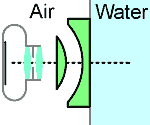 |
Rebikoff-Ivanoff corrector,
in its basic form, consists of a plano-concave front element with a
magnifying element behind. It eliminates the optical
distortion caused by a flat air-water boundary. The lens elements can
be mounted in their own underwater housing, allowing the rear surface
to be placed close to the flat port of an underwater camera housing.
If the intervening water layer is thin, the external lens
corrects for the distortion caused by the port. |
The afocal wide converter became a popular accessory when Olympus,
having decided to make underwater protectors (the PT series) for its
digital compact cameras, started (at model PT-009) to put a filter
thread on the outside of the lens port. At PT-010, the M67
filter thread was introduced, and subsequently became standard for the
larger compact models. Later miniature compacts (the
μ-series) were usually given an M46 thread, although
other sizes were used. Thus there was a small revolution in underwater
photography; the digital compact camera with converter lenses replacing
the interchangeable-lens Nikonos, and perhaps surprisingly, doing a
better job. Other big-name camera manufacturers soon also started to
produce water protectors; and while these housings had no filter thread
because the company decision makers were all psychologically incapable
of providing support for 3
rd-party accessories,
the independent manufacturers soon started to make a variety of M67 and
bayonet port adapters to allow their converter lenses to be used.
The digital camera market reached a
state of maturity in 2004 (there have been worthwhile developments
since then - IS, better signal-to noise ratio, interchangeable lens
compacts - but no radical changes of technology or working practice).
Thus lots of people were using compact cameras underwater; and it
became obvious that digital cameras of ≥ 5Mp (assuming
a decent sensor size) could easily out-perform most 35 mm film cameras.
So it was, at that time, that the author carried out some comparisons
of the various available external wide coverters, and did a little
reverse optical engineering to find out how well they were corrected
for aberration and geometry. Since then, data for more recently
designed lenses have also been added. The whole collection tells a
story, not necessarily of constant progress, but of the challenges
created by the subsequent move to ever-wider zoom lenses, and the
optical degradations that can result.
Converter requirements
Most commentators on the subject of underwater wide converters address
two issues:
1) How wide is it?
2) Does it vignette?
That these are not necessarily the most important considerations
however can be understood as follows:
Firstly, although it is still important
to take photographs from reasonably short range because water is
usually cloudy, the need for extremely short camera-to-subject
distances harks back to a time when photographs were taken on
daylight-balanced transparency film and displayed by direct projection.
Hence there was no opportunity for white-balance correction
and, for example, even at a distance of only 1.25 m, the light path from
flash-to-subject and back to the camera is 2.5 m, meaning that the
exposure at the red end of the spectrum is, in that case, one f-stop
less than at the blue end. Thus all photographs tended to have a bluish
cast, and extreme wide-angle photography was the key to producing
pictures with highly-saturated reds and yellows. Nowadays, of
course, white-balance correction is simply a matter of adjusting the
relative gains of the red, green, and blue image channels; a procedure
that can be carried out in camera or in post-processing (with
negligible loss of quality if a 16-bit per channel RAW format is used).
Hence, it is no longer quite so important to get close, and backing
away a little helps to reduce perspective distortion.
If a supplementary lens vignettes, you
can zoom in. If the image has barrel distortion (see below), you can
also use a computer to restore rectilinearity by applying radial
correction, and this will increase the image area that can be retained
after rectangular cropping. It must be recognised, of course, that
people find optical correction software complicated, and vignetting is
annoying. It can easily be the case however, that a wide
adapter that vignettes to some extent can give better optical
resolution than one that does not. If that is so, then
zooming-in (or even cropping the image later) to remove the vignette
with the good adapter will give better pictures than can be obtained
with the inferior one.
Fixing attention on vignetting and
field-of-view (FOV) somewhat misses what should be the primary purpose
of the attachment lens, which is to turn a very poor wide-angle
underwater camera, i.e., any camera and housing with a flat port, into
a good one (for an analysis of the optical behaviour of the flat port,
see the
flat
port theory article). Thus we re-prioritise.
Listing desirable attributes of wide converters in order of preference
we get:
1) It should correct for the defects
introduced by the flat port on the camera housing (without causing
other forms of optical degradation).
2) It should increase the FOV, at least
restoring it to be the same as given by the camera lens in air.
3) It should not vignette at the full-wide
camera zoom setting (but we might forgive it if it is good at 1 and 2).
Optical considerations
In order to understand what constitutes a good wide converter, it will
be helpful to consider the effect of a flat water-air boundary, and
also the various ideosyncracies of wide-angle lenses.
A lens that preserves straight-lines
and right angles in an image is said to be 'rectilinear'. Assuming that
the camera has a perfect rectilinear lens (rarely the case in practice,
especially at the wide setting of a zoom lens), the effect of a flat
port underwater is to produce pincushion distortion and colour-fringing
in off-centre detail, as shown in the simulation below.
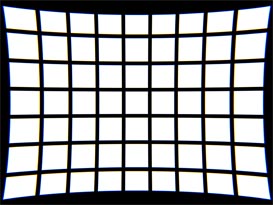
full image |
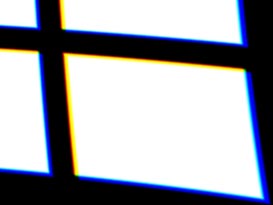
corner detail |
Pincushion distortion occurs because the image magnification increases
approximately in proportion to the cube of the distance from the lens
axis (which corresponds to the mid point of the picture). Points at the
corners of a rectangular object then appear pushed-out because they are
further from the centre than are points at the edges. Colour
fringing (chromatic aberration) occurs because the magnification at the
blue end of the visible spectrum is greater than the magnification at
the red end. Taking the middle colour (green) as reference,
the deviation for blue is about twice that for red, because red is
closer in wavelength to green than blue is. Thus we see a
blue fringe on the outside of a white object, with a fringe of the
complementary colour (yellow) on the inside. Buried
underneath that is a red fringe on the inside, with a complementary
cyan fringe on the outside. The simulation is for a 24 mm lens
(assuming the 35 mm format) behind a flat port. The effect is
less severe for lenses of longer focal length, but bear in mind that
the images above are small. Even at moderate magnification, the
degradation is very noticeable for 28 mm lenses.
The most obvious method of correction
for the defects introduced by a water-air boundary is to place an
air-water boundary parallel to it and a short distance away.
If the two boundaries are close, the distortions introduced
are almost exactly equal and opposite, and it should be obvious that
the correction becomes perfect at the point where the two surfaces come
into contact and all of the water is driven out. To provide the
correcting air-water boundary, of course, we need some kind of
air-filled submersible lens, and the dome converter (see
flat-port vs. dome
port)
is one suitable candidate.
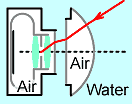 |
Dome converter
The effects of an air-water boundary followed by a water-air boundary
cancel out, provided that the surfaces are parallel and the intervening
water layer is thin. |
The other primary contender is the Rebikoff-Ivanoff corrector that,
although not actually providing a flat air-water boundary at the back
element, nevertheless corrects internally for the geometric distortion
due to the flat port and can be designed with a flat back
surface if so desired. It also has greater potential for modification
than a simple dome converter, but it requires a little more design work
to make it good.
Modern wide-angle converters are not
simple two-element Rebikoff lenses for two reasons. Firstly the
original design has no correction for dispersion in the lens material,
and so it is desirable to include one or more additional elements to
make it achromatic. Secondly, there is some advantage to be had by
adding more elements in order to increase the field-of-view. Thus a
typical formala might involve, say, 5 elements in 4 groups, and even
though it still looks like a Rebikoff lens from the outside, it is much
more complicated internally.
Measures designed to increase the FOV
tend to affect image geometry in ways normally associated with
wide-angle lenses. The usual effect, shown below, is known as
'barrel distortion' if you think that it is a bad thing, and is called
the 'fisheye effect' if you are trying to argue that it is a good
thing. There is also a tendency to introduce more chromatic aberration,
this time of a different appearance to that produced by lens ports, as
illustrated (hypothetically) in the corner detail image, and this
requires further correction.
Fishye distortion is sometimes considered to be a good thing because,
in very wide angle photographs, assuming a flat object field, points
near the centre are much closer to the camera than points at the edge.
This causes perspective distortion, which is offset to some
extent by the fact that the magnification of a fisheye lens diminishes
on moving away from the axis (causing the corners to appear to be
pulled inwards).
Whether the fisheye effect is actually
a good thing is moot. It is certainly deleterious to
technical photography and to the realistic depiction of man-made
objects; but if there is one universal, it is that rectilinear
wide-angle lenses cost a lot more than ones that suffer from barrel
distortion. Also it should be noted, that camera zoom lenses can only
be made perfectly rectilinear at one focal length setting, and they
almost invariably develop barrel distortion at the wide end. This is
one reason why knowledgeable photographers tend to avoid using
super-zoom lenses.
So, we are probably not allowed to
complain about barrel distortion in wide-converter lenses, expecially
if the manufacturer has called it a 'fish-eye' lens.
Fortunately, for technical photographers, the distortion can
be removed in post-processing by applying
radial
correction, and as mentioned earlier, if there
is any cutting-off at the corners, the geometric transformation will
tend to push the vignette out of the final picture.
Inon notation
Inon introduced a convenient nomenclature for wide-angle conversion
lenses and we use it and extend it here. Firstly, a
supplementary lens is designed with a particular minimum focal length
of camera lens in mind. This is very important, because the
FOV of the camera dictates how large the optical aperture of the
converter needs to be (roughly as indicated by the diameter of the back
element) if the system is not to vignette. In practice, this
designation is unreliable because it also depends on the distance from
the entrance pupil of the camera lens to the converter's exit aperture,
and this is by no means controlled from one camera system to the next;
but at least it gives a rough idea of what is likely to work. Secondly,
the lens has a mounting method. Thus we might have, say, a 32M67 lens,
which is designed to work with camera lenses of f ≥
32 mm (35 mm format equivalent) and screws into an M67 filter thread.
Also, we might have, say, a 28LD lens, which works with lenses of
f ≥ 28 mm, and attaches to ports and port adapters
having an Inon LD type bayonet ring; etc.
Note that the design focal length is
only a rough guide. Also, there might be good reason to use a
converter with an under-sized exit aperture and zoom-in a bit.
The design (and marketing) problem
In 2004, which is roughly year zero for high-quality digital underwater
photography, compact cameras had modest (often internal focusing) zoom
lenses with a minimum 35 mm equivalent focal length of 35 mm. Admittedly,
Olympus had brought out the C-5060, which went to 27 mm, and the C-8080,
which went to 28 mm, but neither of the companion housings was intended
to be used with an external wide converter. Thus wide
converters were designed for f = 35 mm lenses (or perhaps a little
shorter to be on the safe side).
The move towards 28 mm maximum-wide was
unavoidable however, and this presents supplementary lens designers
with the problem of where to put the magnification (actually,
de-magnification in the case of a wide converter, but that just means
that the magnification is <1). At f = 28 mm, the camera
is already fairly wide and so, for a given overall FOV, do we let the
camera do the work, or do we let the converter do the work?
This is quite a dilemma, because letting the camera do the
work implies a converter with a large aperture, which will be difficult
to correct; whereas letting the converter do the work, means telling
the customer to zoom in to get rid of the vignette. It is in such
situations that the denizens of the marketiing department are wont to
step-in and speak the otherwise unutterable: most people don't think
about optical resolution, but everyone can see it when the corners are
chopped off.
Some compact cameras now zoom-out to
24 mm . . . . . . .
Lens tests
Wide converter test pictures gathered over a number of years (using a
variety of cameras) are given in the articles that follow. When
viewing those articles, note that the idea is not to measure the
magnification provided by the converter (which is in any case available
from the product literature) but to obtain a quantitave measure of
geometric distortion and chromatic aberration, i.e., we want to know
how well the lens corrects for the water-air boundary and its own
internal defects. The method used is to take test-card pictures and
apply radial corrections using the Panorama Tools 3
rd
party Photoshop filter plugin, the requisite information being obtained
by comparing the correction coefficients. The degree of improvement
obtained after correction might also encourge some readers to give
radial correction a try.
Note also that there are easier ways to
correct images than using the Pano Tools software interface. Some
programs, such as Adobe Photoshop Lightroom offer simple slider
controls that, although having a somewhat restricted adjustment range,
are adequate for most purposes (see
Image radial
correction).

DWK
© David W Knight. 2012, 2018.








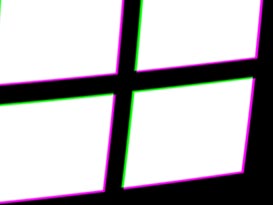
 DWK
DWK